Glen Allen Office
(804) 747-3380
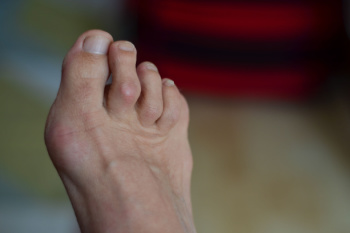
Hammer toes, claw toes, or mallet toes are all results of the toes getting bent into odd positions. They usually look odd and can be painful and often affect the smaller toes. When the toe is bent downward and the middle joint raises up, it is known as a hammertoe. Hammertoes normally happen when bunions occur, and they most often affect the second toe. Claw toes occur when the toes curl up because the middle joints are bent down, and they often affect the four smaller toes at the same time. When the joint closest to the tip of the toe bends downward, it forms a mallet toe. Wearing shoes that are too tight is the most common cause of these conditions, but they can also be linked to diabetes or arthritis. These toe conditions are usually painful and can cause other foot problems, like calluses. If you are struggling with one of these deformities, it is suggested you consult with a podiatrist who can offer treatment options and determine if surgery is necessary.
Hammertoes can be a painful condition to live with. For more information, contact one of our podiatrists of The Podiatry Center. Our doctors will answer any of your foot- and ankle-related questions.
Hammertoe
Hammertoe is a foot deformity that occurs due to an imbalance in the muscles, tendons, or ligaments that normally hold the toe straight. It can be caused by the type of shoes you wear, your foot structure, trauma, and certain disease processes.
Symptoms
Risk Factors
Treatment
If you have hammertoe, you should change into a more comfortable shoe that provides enough room for your toes. Exercises such as picking up marbles may strengthen and stretch your toe muscles. Nevertheless, it is important to seek assistance from a podiatrist in order to determine the severity of your hammertoe and see which treatment option will work best for you.
If you have any questions, please feel free to contact one of our offices located in Richmond and Glen Allen, VA . We offer the newest diagnostic and treatment technologies for all your foot care needs.
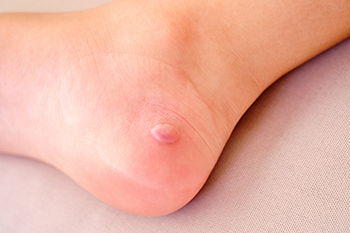
Playing tennis can be tough on the feet due to the high-impact movements and frequent lateral actions that can often lead to painful blisters. These blisters result from the friction between the skin and footwear, which is inevitable during extended matches. While preventive measures like wearing moisture-wicking socks and properly fitted shoes can reduce the risk, sometimes blisters still develop. When this happens, it may help to consult a podiatrist. This foot doctor can provide professional treatment to alleviate pain and promote healing, ensuring you will not have to pause your tennis activities for long. Specialized padding techniques, specific footwear adjustments, or custom orthotics may be offered to minimize future friction. A podiatrist also can provide personalized advice tailored to your specific foot structure and playing style, which can help prevent blisters from recurring. If you frequently develop blisters on the feet, it is suggested that you schedule an appointment with a podiatrist for effective treatment and prevention methods.
Blisters are prone to making everyday activities extremely uncomfortable. If your feet are hurting, contact one of our podiatrists of The Podiatry Center. Our doctors can provide the care you need to keep you pain-free and on your feet.
Foot Blisters
Foot blisters develop as a result of constantly wearing tight or ill-fitting footwear. This happens due to the constant rubbing from the shoe, which can often lead to pain.
What Are Foot Blisters?
A foot blister is a small fluid-filled pocket that forms on the upper-most layer of the skin. Blisters are filled with clear fluid and can lead to blood drainage or pus if the area becomes infected.
How Do Blisters Form?
Blisters on the feet are often the result of constant friction of skin and material, usually by shoe rubbing. Walking in sandals, boots, or shoes that don’t fit properly for long periods of time can result in a blister. Having consistent foot moisture and humidity can easily lead to blister formation.
Prevention & Treatment
It is important to properly care for the affected area in order to prevent infection and ease the pain. Do not lance the blister and use a Band-Aid to provide pain relief. Also, be sure to keep your feet dry and wear proper fitting shoes. If you see blood or pus in a blister, seek assistance from a podiatrist.
If you have any questions, please feel free to contact one of our offices located in Richmond and Glen Allen, VA . We offer the newest diagnostic and treatment technologies for all your foot care needs.

Pain in various parts of the foot can stem from diverse factors. Heel pain, often attributed to plantar fasciitis, results from inflammation of the thick band of tissue connecting the heel to the toes. Arch pain may indicate issues like flat feet or overpronation, where the arch collapses excessively during walking or running. Pain in the ball of the foot could be due to conditions such as metatarsalgia, a result of excessive pressure on the ball of the foot. Additionally, toe pain may result from conditions like bunions, hammertoes, or ingrown toenails. Ankle pain can be caused by sprains, fractures, or Achilles tendon injuries. Contributing factors include overuse, improper footwear, structural abnormalities, and injuries. A diagnosis by a podiatrist is essential for determining the underlying cause of foot pain. If you have pain in your feet, it is strongly urged that you consult this type of doctor who can accurately diagnose and treat foot pain.
Foot Pain
Foot pain can be extremely painful and debilitating. If you have a foot pain, consult with one of our podiatrists from The Podiatry Center. Our doctors will assess your condition and provide you with quality foot and ankle treatment.
Causes
Foot pain is a very broad condition that could be caused by one or more ailments. The most common include:
Diagnosis
To figure out the cause of foot pain, podiatrists utilize several different methods. This can range from simple visual inspections and sensation tests to X-rays and MRI scans. Prior medical history, family medical history, and any recent physical traumatic events will all be taken into consideration for a proper diagnosis.
Treatment
Treatment depends upon the cause of the foot pain. Whether it is resting, staying off the foot, or having surgery; podiatrists have a number of treatment options available for foot pain.
If you have any questions, please feel free to contact one of our offices located in Richmond and Glen Allen, VA . We offer the newest diagnostic and treatment technologies for all your foot care needs.
 Achilles tendonitis is an inflammatory condition affecting the largest tendon in the body, which connects the calf muscles to the heel bone. Inflammation of the Achilles tendon often results from repetitive stress and overuse. It is particularly common in athletes or individuals who engage in activities involving intense running, jumping, or abrupt movements. Symptoms typically include pain and stiffness along the tendon, especially in the morning or after periods of inactivity, and swelling or tenderness. To manage Achilles tendinitis, it is important to reduce activities that cause or increase the pain. Resting and taking anti-inflammatory medications can help alleviate symptoms. Stretching and strengthening exercises for the calf muscles are also beneficial in promoting flexibility and support. Wearing supportive footwear or orthotics can provide additional relief by reducing strain on the Achilles tendon. If you have this condition and it persists or worsens, it is suggested that you schedule an appointment with a podiatrist.
Achilles tendonitis is an inflammatory condition affecting the largest tendon in the body, which connects the calf muscles to the heel bone. Inflammation of the Achilles tendon often results from repetitive stress and overuse. It is particularly common in athletes or individuals who engage in activities involving intense running, jumping, or abrupt movements. Symptoms typically include pain and stiffness along the tendon, especially in the morning or after periods of inactivity, and swelling or tenderness. To manage Achilles tendinitis, it is important to reduce activities that cause or increase the pain. Resting and taking anti-inflammatory medications can help alleviate symptoms. Stretching and strengthening exercises for the calf muscles are also beneficial in promoting flexibility and support. Wearing supportive footwear or orthotics can provide additional relief by reducing strain on the Achilles tendon. If you have this condition and it persists or worsens, it is suggested that you schedule an appointment with a podiatrist.
Achilles tendon injuries need immediate attention to avoid future complications. If you have any concerns, contact one of our podiatrists of The Podiatry Center. Our doctors can provide the care you need to keep you pain-free and on your feet.
What Is the Achilles Tendon?
The Achilles tendon is a tendon that connects the lower leg muscles and calf to the heel of the foot. It is the strongest tendon in the human body and is essential for making movement possible. Because this tendon is such an integral part of the body, any injuries to it can create immense difficulties and should immediately be presented to a doctor.
What Are the Symptoms of an Achilles Tendon Injury?
There are various types of injuries that can affect the Achilles tendon. The two most common injuries are Achilles tendinitis and ruptures of the tendon.
Achilles Tendinitis Symptoms
Rupture Symptoms
Treatment and Prevention
Achilles tendon injuries are diagnosed by a thorough physical evaluation, which can include an MRI. Treatment involves rest, physical therapy, and in some cases, surgery. However, various preventative measures can be taken to avoid these injuries, such as:
If you have any questions please feel free to contact one of our offices located in Richmond and Glen Allen, VA . We offer the newest diagnostic tools and technology to treat your foot and ankle needs.
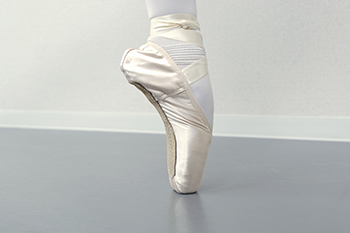
In ballet, the coordination of foot bones is essential for achieving fluid and graceful movements. During a tendu, the foot extends and stretches, with the bones and tendons working together to create a smooth, elongated line. A plié involves bending the knees while keeping the feet firmly grounded, requiring precise articulation of the ankle and foot bones to maintain balance and control. Port-de-bras, the movement of the arms in coordination with the feet, enhances overall fluidity and expression. Effective foot and ankle articulation involves strengthening the muscles and tendons surrounding these areas to ensure flexibility and stability. Proper technique and consistent practice help ballet dancers achieve aesthetic, elegant movements and avoid injury through careful, controlled use of the foot bones and surrounding structures. If you are a ballet dancer, and have injured your foot or ankle, it is suggested that you consult a podiatrist who can provide treatment and guide you on how to perform specific stretches for optimal results.
If you have any concerns about your feet, contact one of our podiatrists from The Podiatry Center. Our doctors can provide the care you need to keep you pain-free and on your feet.
Biomechanics in Podiatry
Podiatric biomechanics is a particular sector of specialty podiatry with licensed practitioners who are trained to diagnose and treat conditions affecting the foot, ankle and lower leg. Biomechanics deals with the forces that act against the body, causing an interference with the biological structures. It focuses on the movement of the ankle, the foot and the forces that interact with them.
A History of Biomechanics
Modern technological improvements are based on past theories and therapeutic processes that provide a better understanding of podiatric concepts for biomechanics. Computers can provide accurate information about the forces and patterns of the feet and lower legs.
Understanding biomechanics of the feet can help improve and eliminate pain, stopping further stress to the foot.
If you have any questions please feel free to contact one of our offices located in Richmond and Glen Allen, VA . We offer the newest diagnostic and treatment technologies for all your foot and ankle needs.
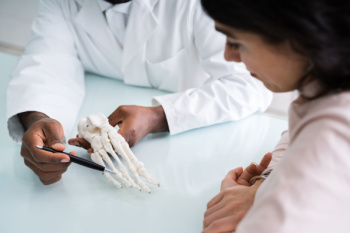
Foot, ankle, or toe pain can significantly impact your daily life, making even simple tasks challenging. For instance, runners often experience stress fractures or Achilles tendon pain, which a podiatrist can treat through diagnostic testing and appropriate treatment. Arthritis in the feet and ankles can cause swelling, stiffness, and pain, but a podiatrist can suggest treatments to maintain joint health and improve mobility. Diabetic patients should see a podiatrist regularly to manage foot health and prevent serious complications. Persistent heel pain, whether from heel spurs or plantar fasciitis, requires professional diagnosis and treatment to restore comfort and function. Ingrown toenails, if left untreated, can lead to painful infections that a podiatrist can effectively address. Injuries like sprains, strains, or fractures also necessitate a visit to a podiatrist for an accurate diagnosis. Conditions such as corns, calluses, bunions, and athlete’s foot can be managed with the expertise of a podiatrist, relieving pain and preventing further problems. If you are experiencing foot, ankle, or toe pain, it is suggested that you schedule an appointment with a podiatrist for an exam, diagnosis, and treatment options.
If you are experiencing pain in the feet or ankles, don’t join the stubborn majority refusing treatment. Feel free to contact one of our podiatrists from The Podiatry Center. Our doctors can provide the care you need to keep you pain-free and on your feet.
What Is a Podiatrist?
Someone would seek the care of a podiatrist if they have suffered a foot injury or have common foot ailments such as heal spurs, bunions, arch problems, deformities, ingrown toenails, corns, foot and ankle problems, etc.
Podiatric Treatment
A podiatrist will treat the problematic areas of the feet, ankle or lower leg by prescribing the following:
A common podiatric procedure a podiatrist will use is a scanner or force plate which will allow the podiatrist to know the designs of orthotics. Patients are then told to follow a series of tasks to complete the treatment. The computer will scan the foot a see which areas show weight distribution and pressure points. The podiatrist will read the analysis and then determine which treatment plans are available.
If you have any questions please feel free to contact one of our offices located in Richmond and Glen Allen, VA . We offer the newest diagnostic and treatment technologies for all your foot and ankle needs.
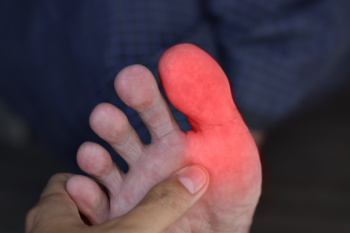 Toe pain can arise from various conditions, each requiring careful attention. Bunions, a common cause, involve a bony bump forming at the base of the big toe, leading to discomfort and swelling. Arthritis, particularly osteoarthritis and rheumatoid arthritis, can cause joint inflammation and stiffness, affecting toe movement. Infections, whether fungal or bacterial, may result in redness, swelling, and severe pain. Injuries such as fractures or sprains often lead to immediate and intense pain, impairing mobility. Peripheral artery disease, or PAD, restricts blood flow to the extremities, causing pain, especially during walking. If you have toe pain, it is suggested that you visit a podiatrist who can determine the cause and offer appropriate treatment solutions.
Toe pain can arise from various conditions, each requiring careful attention. Bunions, a common cause, involve a bony bump forming at the base of the big toe, leading to discomfort and swelling. Arthritis, particularly osteoarthritis and rheumatoid arthritis, can cause joint inflammation and stiffness, affecting toe movement. Infections, whether fungal or bacterial, may result in redness, swelling, and severe pain. Injuries such as fractures or sprains often lead to immediate and intense pain, impairing mobility. Peripheral artery disease, or PAD, restricts blood flow to the extremities, causing pain, especially during walking. If you have toe pain, it is suggested that you visit a podiatrist who can determine the cause and offer appropriate treatment solutions.
Toe pain can disrupt your daily activities. If you have any concerns, contact one of our podiatrists of The Podiatry Center. Our doctors can provide the care you need to keep you pain-free and on your feet.
What Causes Toe Pain?
Most severe toe pain is caused due to a sports injury, trauma from dropping something heavy on the toe, or bumping into something rigid. Other problems can develop over time for various reasons.
Toe pain can be caused by one or more ailments. The most common include:
When to See a Podiatrist
Diagnosis
In many cases the cause of toe pain is obvious, but in others, a podiatrist may want to use more advanced methods to determine the problem. These can range from simple visual inspections and sensation tests to X-rays and MRI scans. Prior medical history, family medical history, and any recent physical traumatic events will all be taken into consideration for a proper diagnosis.
Treatment
Treatments for toe pain and injuries vary and may include shoe inserts, padding, taping, medicines, injections, and in some cases, surgery. If you believe that you have broken a toe, please see a podiatrist as soon as possible.
If you have any questions please feel free to contact one of our offices located in Richmond and Glen Allen, VA . We offer the newest diagnostic tools and technology to treat your foot and ankle needs.
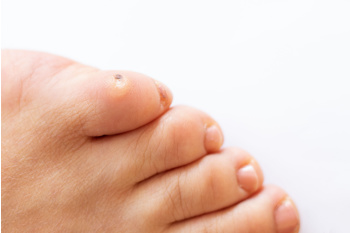 Corns and calluses are common foot conditions that are often confused but have distinct differences. Corns are small, rounded areas of thickened skin that usually develop on bony areas like the top or sides of toes as a result of pressure or friction. Corns often develop from the consistent friction with ill-fitted shoes. Typically, corns have a hard core surrounded by inflamed skin that may cause discomfort or pain when pressure is applied. Calluses, on the other hand, are broader, more diffused areas of thickened skin that typically form on the soles of the feet or the palms of the hands. Calluses form as the body's way of protecting itself from ongoing rubbing or pressure from everyday activities like walking, working, or any kind of manual labor. Unlike corns, calluses generally do not cause pain but they may affect mobility if they grow too thick. Regular foot care and attention to shoe fit can help maintain healthy feet and prevent the development of these agitating conditions. If you suffer from persistent or painful corns and calluses, it is suggested that you visit a podiatrist for a proper evaluation and appropriate treatment recommendations.
Corns and calluses are common foot conditions that are often confused but have distinct differences. Corns are small, rounded areas of thickened skin that usually develop on bony areas like the top or sides of toes as a result of pressure or friction. Corns often develop from the consistent friction with ill-fitted shoes. Typically, corns have a hard core surrounded by inflamed skin that may cause discomfort or pain when pressure is applied. Calluses, on the other hand, are broader, more diffused areas of thickened skin that typically form on the soles of the feet or the palms of the hands. Calluses form as the body's way of protecting itself from ongoing rubbing or pressure from everyday activities like walking, working, or any kind of manual labor. Unlike corns, calluses generally do not cause pain but they may affect mobility if they grow too thick. Regular foot care and attention to shoe fit can help maintain healthy feet and prevent the development of these agitating conditions. If you suffer from persistent or painful corns and calluses, it is suggested that you visit a podiatrist for a proper evaluation and appropriate treatment recommendations.
If you have any concerns regarding your feet and ankles, contact one of our podiatrists of The Podiatry Center. Our doctors will treat your foot and ankle needs.
Corns: What Are They? and How Do You Get Rid of Them?
Corns can be described as areas of the skin that have thickened to the point of becoming painful or irritating. They are often layers and layers of the skin that have become dry and rough, and are normally smaller than calluses.
Ways to Prevent Corns
There are many ways to get rid of painful corns such as wearing:
Treating Corns
Treatment of corns involves removing the dead skin that has built up in the specific area of the foot. Consult with Our doctors to determine the best treatment option for your case of corns.
If you have any questions please feel free to contact one of our offices located in Richmond and Glen Allen, VA . We offer the newest diagnostic and treatment technologies for all your foot and ankle needs.